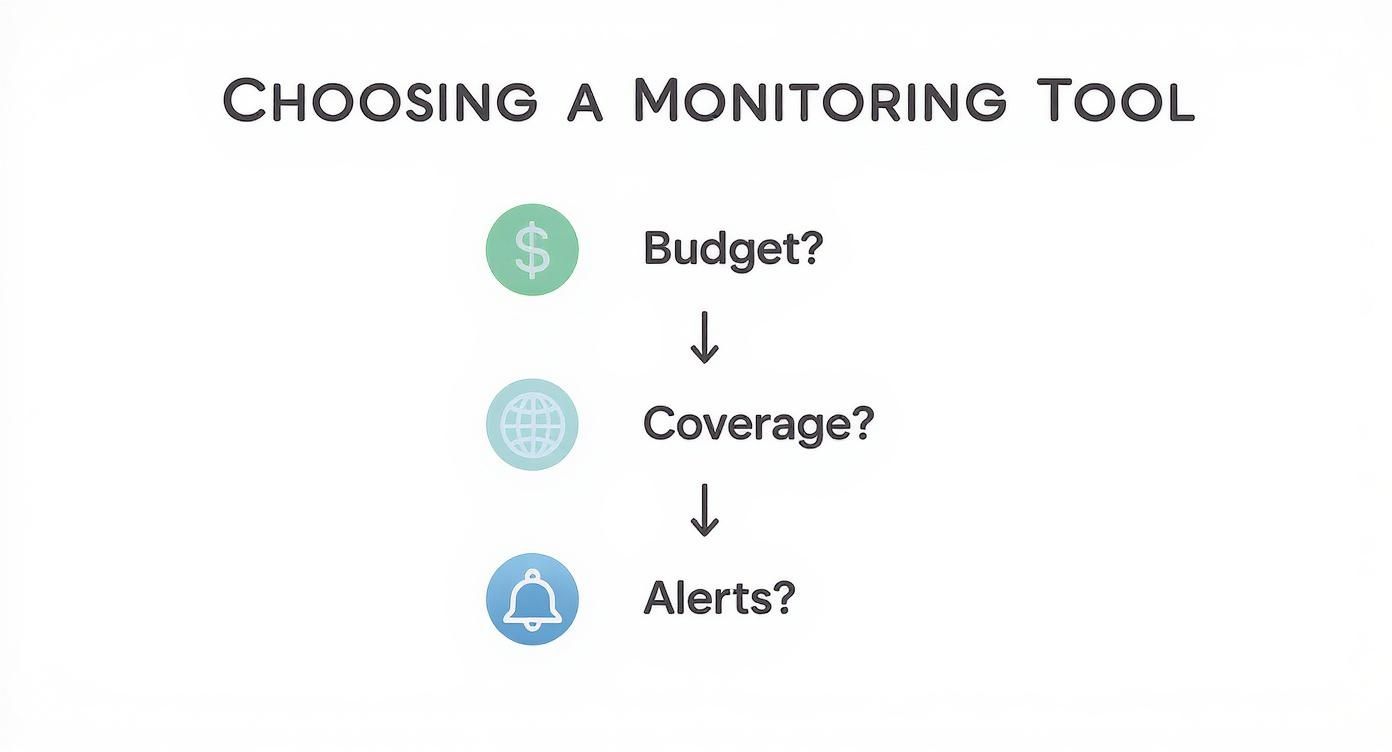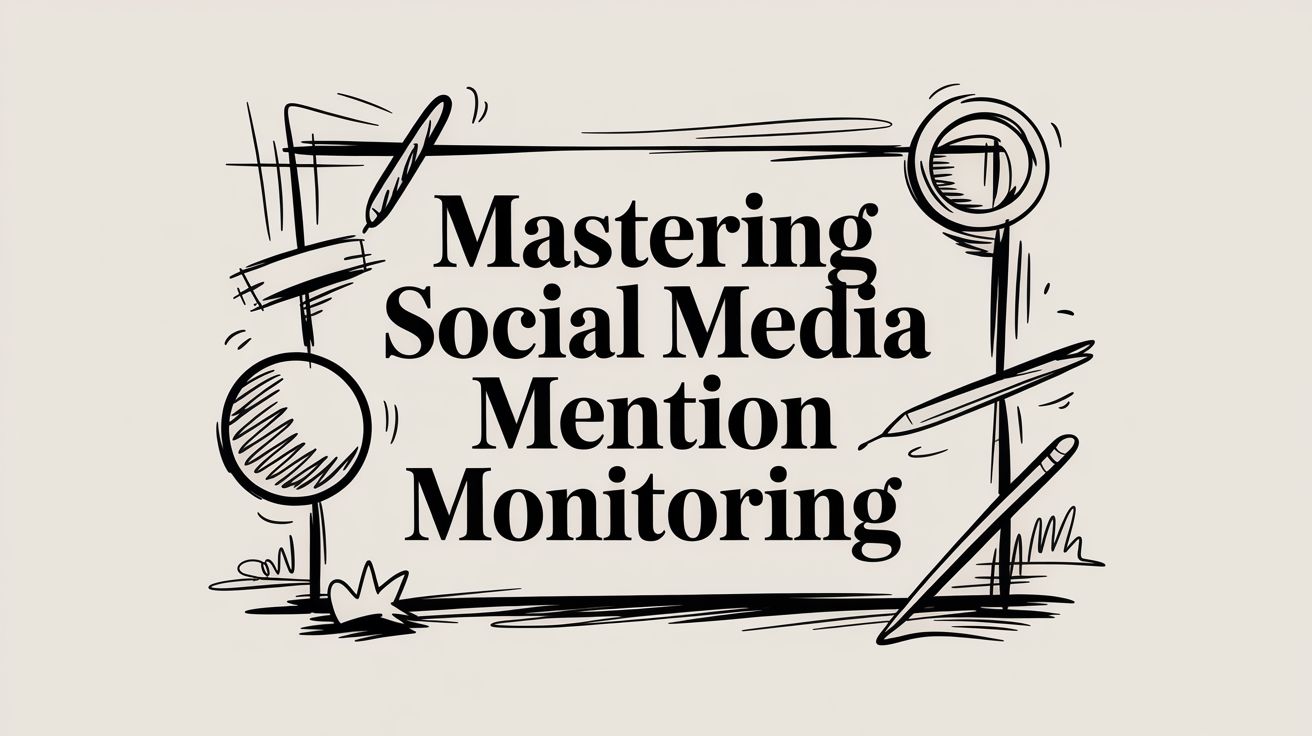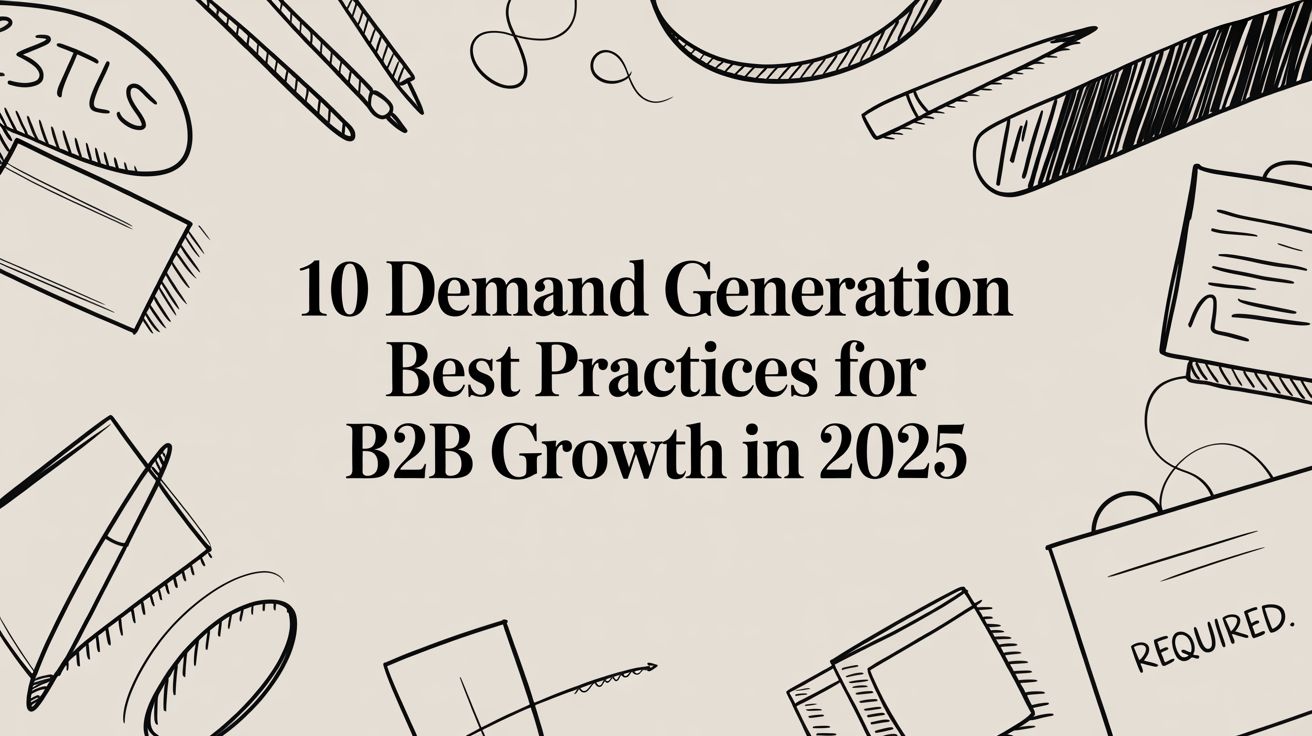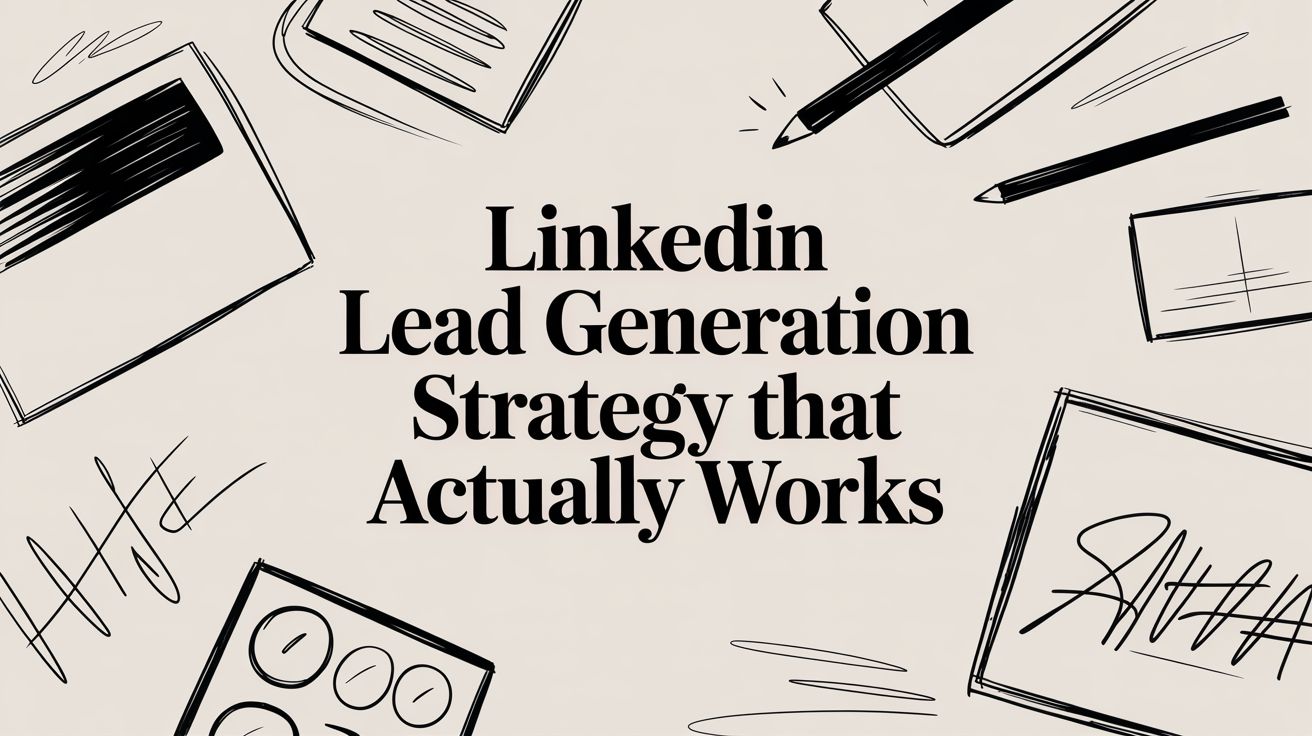Social media mention monitoring—often called social listening—is the art of keeping your finger on the pulse of online conversations about your brand. It’s moved way beyond a simple marketing checklist item; it's now a core part of how smart businesses gather intelligence, read the room, and protect their hard-earned reputation.
Why Mention Monitoring Is No Longer Optional

Gone are the days when brands could just broadcast a message through ads and PR. Now, the conversation is happening everywhere, all the time, with or without you. Your customers are on X (formerly Twitter), Reddit, and TikTok, sharing their unfiltered thoughts.
Ignoring these conversations is like letting your customer support line ring off the hook. At best, it’s a missed opportunity. At worst, it’s a recipe for disaster.
Get Unfiltered Customer Insights
Think of social media as the world's biggest, most honest focus group—and it’s running 24/7. People are openly discussing what they love about your product, what drives them crazy, and the features they’re begging you to build. This constant stream of feedback is pure gold for your product, marketing, and support teams.
Effective social media mention monitoring transforms that firehose of chatter into actionable insights. It’s how you spot a recurring bug before it becomes a major problem or discover a creative new way people are using your product that you can turn into your next marketing campaign.
Proactively Manage Your Reputation
It only takes one viral post to ignite a PR firestorm. In today’s world, early detection is your only real defense. Monitoring lets you catch negative comments or misinformation before they go viral, giving you a crucial window to respond, correct the record, and steer the conversation.
By tracking mentions in real time, you shift from reactive damage control to proactive reputation management. This is fundamental to building a brand that can weather online storms.
This kind of vigilance is a cornerstone of any solid crisis communication planning strategy. More than just putting out fires, it shows your audience you're listening and you care, which is a massive trust-builder.
Find and Supercharge Your Brand Advocates
For every critic, there’s often a superfan. These are your brand advocates, your most authentic and powerful marketers. They’re already out there singing your praises, and monitoring helps you find them.
Once you’ve identified these champions, you can engage with them directly, amplify their positive reviews, or even collaborate on user-generated content. Acknowledging their support turns casual fans into loyal evangelists. There are tons of ways this can fuel growth, which we cover in our guide to social media monitoring benefits.
How Monitoring Drives Key Business Goals
Social listening isn't just for the marketing department. When done right, the insights you gather can inform decisions and drive results across the entire organization.
Table: Core Functions of Social Media Monitoring
| Business Function | How Monitoring Helps | Example Outcome |
|---|---|---|
| Product Development | Gathers direct feedback on feature requests, bugs, and user experience pain points. | A SaaS company notices repeated requests for a dark mode and prioritizes it in the next sprint. |
| Customer Support | Identifies support issues posted on public channels, allowing for proactive help. | A telco spots a tweet about a local outage and responds with an ETA before a support ticket is filed. |
| Marketing & PR | Uncovers user-generated content, audience sentiment, and competitor activity. | A clothing brand finds an influencer's post and re-shares it, reaching a new, engaged audience. |
| Sales & Lead Gen | Finds conversations where potential customers are asking for recommendations. | A software provider joins a LinkedIn discussion to answer questions, generating a warm lead. |
Ultimately, a well-executed monitoring strategy ensures that the voice of the customer is heard in every room where decisions are made.
The scale of this conversation is just staggering. Projections show the number of global social media users hitting 5.42 billion by 2025—that's nearly 67% of the global population. With an audience that massive, mentions are happening constantly, making effective monitoring a non-negotiable for any modern business.
Laying the Groundwork for Your Mention Monitoring

Before you even think about software or workflows, you need a map. The diagram above isn't just a collection of words; it’s a strategic blueprint showing how interconnected your brand's world really is. An effective monitoring setup isn't about just catching mentions of your brand name—it's about understanding the entire ecosystem of conversations that shape your market.
This initial keyword mapping is, without a doubt, the most critical piece of the puzzle. It’s what separates a feed full of actionable insights from an inbox overflowing with noise.
If you only track your brand name, you're essentially looking at your city through a keyhole. You'll see what’s happening directly in front of you, but you'll miss the traffic jams, the new construction, and the community events happening just around the corner.
Building Your Keyword Universe
To cast the right net, you have to think in layers. We’ll break it down into three buckets: the essentials (primary keywords), the strategic outreach (secondary keywords), and the noise-cutters (negative keywords). Nailing this mix is the secret to turning a firehose of data into a focused stream of opportunities.
First, let's cover your primary keywords. These are the absolute non-negotiables, the terms tied directly to your brand's identity.
- Your Brand Name: Don't forget common misspellings or abbreviations. If your company is "Replymer," you need to be tracking "Replymur" and "Replymr," too.
- Products & Services: Get specific. List out every individual offering, like "Replymer for Reddit" or "Replymer for Startups."
- Your Key People: Your CEO, founder, or other public-facing team members are part of your brand. What people say about them reflects on the company.
- Branded Hashtags: Make sure you're tracking any hashtags you've created for campaigns or your community, such as
#ReplymerGrowth.
Expanding Your Reach to Find Hidden Opportunities
Now, let's move beyond your own backyard. Secondary keywords are your ears to the ground, helping you tune into the broader industry conversation and keep an eye on the competition. This is where you unearth chances to engage proactively.
This is the step that transforms your monitoring tool from a simple alert system into a powerful business intelligence engine. You start spotting trends, identifying competitor weaknesses, and finding potential customers before they even realize they need a solution like yours.
Think of these keywords as listening in on the conversations happening next door. They provide the context you'd otherwise miss.
H3: Tapping into Competitor and Industry Chatter
Monitoring the Competition
- Direct Competitors: Track their brand and product names. You'll be amazed at what you can learn from their customers' unfiltered feedback.
- Feature-Specific Pain Points: Listen for complaints about features where your product excels. If their users are constantly griping about "slow reporting," that’s your cue to jump in.
Monitoring Industry Topics
- Niche Jargon: Track the specific phrases your ideal customers use every day, like "B2B lead generation" or "SaaS content marketing."
- Problem-Based Questions: People often describe their problems online before they look for a solution. Monitor questions like, "How do I find sales leads on Reddit?" or "What's the best way to get clients on X?"
Finally, you need a filter. That's where negative keywords come in. They are absolutely essential for cleaning up your results, especially if your brand name is a common word. If your company is called "Talon," you’d want to add negative keywords like -bird or -eagle to stop your feed from filling up with conversations about ornithology.
Getting Surgical with Boolean Search
Just having a list of keywords won't cut it. You need to combine them with precision, and for that, Boolean operators—simple commands like AND, OR, and NOT—are your best friends. They let you build incredibly specific queries.
The explosion of user-generated content has pushed social media analytics tools to evolve far beyond simple keyword matching. Modern tools can analyze everything from text to images and video, and at their core is the ability to run Boolean searches. This helps you zero in on relevant conversations across platforms like TikTok, Reddit, and YouTube. You can dive deeper into the history and methods of social media analytics to see just how far these techniques have come.
Here's a quick cheat sheet on putting them to work:
- AND narrows your search.
Replymer AND "customer service"will only show you mentions containing both terms. - OR broadens your search.
"customer support" OR "client help"finds mentions with either of those phrases. - NOT excludes terms.
Apple NOT fruitis a classic example for filtering out irrelevant chatter.
Let's put it all together. A SaaS company could build a query like this: ("competitor A" OR "competitor B") AND ("bug" OR "slow" OR "crash") NOT ("hiring" OR "jobs").
This isn't just a search; it's a lead generation machine. It specifically targets people complaining about your competitors while filtering out all their job postings, leaving you with a clean, actionable list of prospects.
Choosing and Configuring Your Monitoring Tools
With your keyword map ready, it's time to pick the tech that will actually do the heavy lifting. The market is absolutely flooded with social media monitoring tools, and honestly, they all claim to be the best. The secret isn't finding the "best" one overall, but finding the right one for you.
It’s a classic Goldilocks problem. If you're a small startup, diving into a massive, enterprise-level platform like Sprinklr is overkill. You'll be paying a fortune for features you never touch and wrestling with a complex interface. On the flip side, a simple tool designed for small businesses will fall flat for a global brand trying to track multiple products across a dozen languages.
How to Actually Evaluate Monitoring Tools
Don't get distracted by the slick demos and flashy dashboards. You need a simple, practical framework to figure out what actually matters for your team. Here’s what I always look at:
- Platform Coverage: Where do your people actually talk? If your audience is deep in niche subreddits but the tool only scrapes X (formerly Twitter), it's useless. Make a list of your must-have platforms—social networks, forums, blogs, review sites—and check them off.
- Sentiment Analysis that Works: Nearly every tool offers sentiment analysis, but most are… not great. They can easily get tripped up by sarcasm or industry slang. You need a tool that can tell the difference between "this is sick" (good) and "I'm sick of this" (bad). The goal is to get a real feel for emotion, not just a sterile keyword count.
- Alerts You Can't Ignore: You can't have someone glued to a dashboard 24/7. That's why solid alerting is non-negotiable. Can it ping your team on Slack the second a high-profile influencer mentions you? Can you set up an email trigger for a sudden spike in negative comments? This is your front line for reputation management.
- Workflow Integrations: Your monitoring tool shouldn't be an island. To be truly effective, it needs to connect with the tools you already use. Think about it: can it push a frustrated customer’s comment into your CRM to create a support ticket? Can it send a task to your project management app? Smooth integrations turn monitoring from a chore into a core part of your business.
For a really deep dive, our social listening tools comparison breaks down the top players side-by-side to help you narrow down the field.
Setting Up Your Tool for Maximum Impact
Once you’ve made your choice, the real work begins. The initial setup is where you translate your strategy into action, fine-tuning the tool to cut through the noise and surface conversations that actually matter.
Your first move is to meticulously input the keyword map you built. This isn't just a copy-paste job. You need to translate your primary, secondary, and negative keywords—along with any of those clever Boolean queries—into the tool's project or search setup. Get this right, and you'll save yourself countless hours of sifting through irrelevant mentions later.
An organized dashboard like the one above is what you're aiming for. It transforms a chaotic firehose of data into clean, manageable streams, letting you see exactly what's happening in different parts of your world.
A well-configured dashboard doesn't just show you data; it tells a story. At a glance, you should be able to see what customers are saying about your latest feature, how a competitor's new campaign is landing, and whether overall sentiment is trending up or down.
Modern tools have become incredibly good at this. Platforms like Mention use AI-driven features like "spike alerts" that instantly flag a sudden surge in conversation volume. This is an absolute game-changer for crisis management, giving you a critical heads-up before things spiral.
The final piece of the puzzle is customizing your dashboards and reports. Never settle for the default layout. Build views that match what your teams actually care about. Your customer support team, for instance, probably needs a dashboard zeroed in on bug reports and feature requests. Meanwhile, your marketing team will want to track campaign hashtags and influencer chatter. This kind of personalization makes sure everyone gets the insights they need, fast.
Crafting Your Triage and Response Workflow
So, you've got a steady stream of mentions flowing in. Great! But collecting them is just the starting line. The real magic—and the real business results—happen when you know exactly what to do with them. Without a solid system, you're just staring at a chaotic feed of notifications, reacting instead of acting.
Think of your mentions inbox like an emergency room. A paper cut and a major trauma don't get the same treatment. The same logic applies here. You need a way to quickly assess, categorize, and prioritize every single mention so the most critical conversations get handled first. This is where a triage and response workflow transforms raw data into a well-oiled machine for engagement and support.
Setting Up Your Triage Protocol
The first step is sorting. Triage is all about bucketing mentions based on what they are, how they feel (sentiment), and what they require from you. This initial filter is crucial. It lets your team zero in on high-priority issues immediately, while everything else gets handled efficiently without causing distractions.
Most of the mentions you see will probably fall into one of these buckets:
- Urgent Customer Support: These are your "fire alarm" mentions. Users are hitting a wall with bugs, service outages, or other problems. They need a fast, helpful, and empathetic response.
- Positive Feedback & Praise: This is pure gold. We're talking shout-outs, compliments, and success stories from people who love what you do.
- General Questions & Inquiries: These often come from potential customers or current users who are curious about features, pricing, or how to get the most out of your product.
- Competitor Mentions: People might be directly comparing you to a rival, complaining about a competitor's service (an opportunity!), or looking for alternatives.
- Influencer & Media Mentions: Any post from a high-profile account, journalist, or industry publication. These can have a massive impact on your reach, for better or worse.
A well-defined triage system is the difference between controlled, strategic engagement and constantly playing defense. By sorting mentions upfront, you empower your team to focus their energy where it will have the biggest impact.
To put this into action, you'll need the right tools in place. This flowchart breaks down the core decisions—budget, coverage, and alerts—that you'll face when choosing a platform, which is the foundation of any good monitoring workflow.

As you can see, picking the right tool isn't a one-size-fits-all deal. It's about making a strategic choice based on your team's specific needs and resources.
Here's a simple framework you can adapt for your own team.
| Mention Triage and Response Protocol |
| :--- | :--- | :--- | :--- |
| Mention Type | Priority Level | Assigned Team | Response Time Goal |
| Urgent Support (e.g., bug, outage) | High | Customer Support | < 1 hour |
| Negative Feedback (non-urgent) | Medium | Customer Success | < 4 hours |
| Sales Inquiry (e.g., pricing) | High | Sales/Marketing | < 2 hours |
| Positive Praise | Medium | Community/Marketing | < 8 hours |
| Influencer/Media Mention | High | PR/Comms | < 1 hour |
This protocol ensures everyone knows their role and how quickly they need to act, creating a consistent and reliable experience for your audience.
Crafting On-Brand Replies That Actually Work
Once a mention is sorted, it's time to reply. Consistency is everything. Your brand's voice should come through clearly whether you're handling a complaint or celebrating a win. This is where response templates can be a lifesaver, ensuring consistency while freeing up your team's time.
But let's be clear: these are not meant to be rigid, copy-and-paste scripts. Think of them more as flexible frameworks that guide the conversation. A good template captures the right tone and key info, but leaves plenty of room for personalization.
Example Response Frameworks
For a Negative Comment:
- Acknowledge their frustration right away.
- Sincerely apologize for the bad experience.
- Quickly move the conversation to a private channel (like a DM or email) to get the details and fix the problem.
- Template: "We're so sorry to hear you're running into trouble with [feature]. That's definitely not the experience we want for you. Could you send us a DM with your account details so we can investigate this for you right away?"
For a Positive Shout-Out:
- Thank them with genuine enthusiasm. Use their name!
- Keep the conversation going by asking a follow-up question or highlighting something specific they said.
- Template: "This just made our day, [Name]! We're thrilled to hear you're loving the [feature]. What's the most useful part for you so far?"
Automate Your Workflow So You Can Scale
As your brand grows, manually sorting and assigning every single mention just isn't going to cut it. It's a recipe for burnout and missed opportunities. This is where you bring in the power of automation. Most modern social media monitoring tools, like Brandwatch or Sprout Social, let you create rules that process mentions for you.
You can set up rules to:
- Auto-Tag Mentions: Automatically apply tags like "Urgent," "Feedback," or "Competitor" based on keywords found in the mention.
- Assign to the Right Team: Any mention containing words like "broken" or "error"? Route it straight to the customer support queue.
- Trigger Notifications: Get an instant Slack notification when a mention comes from an account with over 100,000 followers.
By setting up these rules, your monitoring tool becomes a proactive system that organizes conversations before a human even has to look at them. It cuts down on manual work, shrinks your response times, and makes sure no critical mention ever slips through the cracks.
Measuring ROI and Scaling Your Program
https://www.youtube.com/embed/OINm6oQBFkc
Look, running a tight ship with your social media monitoring is great, but the job isn't finished until you can prove its worth. Sooner or later, someone from leadership is going to walk over to your desk and ask, "What are we actually getting from all this?" To answer that, you need to go way beyond simply counting how many mentions you found.
It’s not about showing how busy your team is. It’s about connecting what you’re doing day-to-day to real business results—things like protecting the brand’s reputation, making customers happier, and even teeing up new sales leads.
Moving Beyond Vanity Metrics
First things first: let's redefine what "success" even means here. Tallying up mentions is a vanity metric. Instead, you need to focus on KPIs that actually tell a story about your brand's health and how people feel about you.
Here’s what really matters:
- Sentiment Trend Analysis: Is the vibe around your brand getting better over time? A steady climb in positive mentions is concrete proof that your engagement strategy and product updates are hitting the mark.
- Share of Voice (SOV): How much of the conversation in your industry do you own compared to your competitors? If your SOV is growing, you're becoming more relevant. Simple as that.
- Response Time and Resolution Rate: When a customer has a problem and you spot it, how fast do you jump on it? And how often do you actually solve it? These numbers are a direct line to customer satisfaction.
Proving ROI isn't just a reporting task; it's a strategic necessity. Warren Talbot, Marketing Manager at Vans, highlighted this challenge, noting that getting sign-off from upper management is difficult "without hard facts, data and ROI." Your reports must provide that data to justify and expand your efforts.
When you track these metrics consistently, you can start connecting the dots. Imagine being able to walk into a meeting and show that a 15% drop in negative sentiment happened right after you rolled out a new support workflow—one you created based on what you learned from monitoring. That’s not just data; it’s a story with a clear, valuable outcome.
Communicating Value to Stakeholders
Once you have your numbers, you need to package them in a way that’s easy to understand and impossible to ignore. A monthly monitoring report is perfect for this, but please, ditch the overwhelming spreadsheets. Think visual.
Your report should be built around a few key components:
- Executive Summary: Lead with the highlights. What were the big wins? What trends are you seeing? What fires did you put out this month?
- KPI Dashboard: Use simple charts and graphs to show your core metrics. A line graph showing sentiment trends over the last quarter is way more powerful than a table of numbers.
- Qualitative Highlights: Give them a taste of the real world. Pull a screenshot of a fantastic customer shout-out you engaged with, or show how you turned a frustrated customer into a happy one.
- Actionable Insights: This is the most important part. Don't just present the data—tell them what it means. What did you learn? Based on these findings, what should the company do next?
Of course, it all comes back to money eventually. If you need to translate your social media efforts directly into dollars and cents, our guide on how to calculate marketing ROI offers a solid framework for doing just that.
Scaling Your Monitoring Program
As your brand gets bigger, your monitoring program has to grow with it. And scaling isn't just about doing more—it's about getting smarter.
Initially, scaling might just mean adding keywords for new products, campaigns, or maybe expanding into a new country. That's the easy part.
The real leap forward comes from using technology to your advantage. Many modern monitoring tools have AI-powered features that can automatically sort mentions by topic, flag sentiment shifts, or spot emerging trends before they blow up. This is how a small team can handle a huge volume of conversations without drowning in manual work.
Ultimately, the goal is to weave this social data into the fabric of your business. By integrating your monitoring tool with your CRM or other business intelligence systems, you create a complete picture of your customer. That's when social insights stop being a marketing-only asset and become a core part of how the entire company operates.
Common Questions You'll Probably Ask
Even with the best tools and a solid plan, you're going to have questions as you get your social media mention monitoring program running. I've seen teams run into the same hurdles time and time again, so let's get ahead of them. Answering these common questions now will save you a ton of headaches later.
Social Media Monitoring vs. Social Listening
This one comes up constantly, and the distinction is more than just semantics—it's fundamental to your strategy. People tend to use the terms interchangeably, but they really are two different sides of the same coin.
Here's how I like to think about it: monitoring is seeing the individual trees, while listening is understanding the entire forest.
Social media monitoring is the day-to-day, reactive work of catching individual mentions and jumping into conversations. Social listening is the proactive work of analyzing all that data to spot bigger trends, gauge customer sentiment, and see what your competitors are up to.
You absolutely need both. You monitor to help a customer who's stuck right now. You listen to realize that hundreds of customers are getting stuck in the same spot, which tells you there's a problem with your onboarding flow or help docs.
How to Handle Negative Mentions Without Making It Worse
Seeing a nasty comment about your brand can feel like a gut punch. I get it. But your reaction can either pour fuel on the fire or turn a critic into a fan. The absolute worst thing you can do is get defensive or, even worse, delete the comment.
Instead, take a breath and follow this simple playbook:
- Respond Quickly and Publicly: A fast reply shows you’re paying attention. Acknowledge their frustration out in the open so everyone else sees you're responsive. Whatever you do, don't get into an argument.
- Take It to DMs: Offer to sort out the specifics in a private channel, like DMs or email. This gets the messy details out of the public timeline and allows you to gather the info you need to actually help them.
- Actually Fix the Problem: This is the most important part. Use the feedback. Was it a bug? A confusing policy? A support agent having a bad day? Get to the root cause so it doesn't happen to the next person.
A timely, empathetic, and solution-focused response almost always works. It shows you're a brand that listens and takes responsibility, which builds a surprising amount of goodwill.
How Often Should I Be Checking for Mentions?
The honest answer? It depends. There’s no magic number here; it all comes down to how many mentions you get and what industry you're in.
For a lot of B2B or lower-volume brands, checking in once or twice during the workday is plenty. You can easily stay on top of things without being glued to a dashboard.
On the other hand, if you're a high-volume B2C brand in retail, travel, or gaming, things get a lot more intense. A single service outage can trigger a firestorm of mentions in minutes, so "continuous monitoring" is closer to the truth.
This is where your tool's real-time alerts become your best friend. Don't just rely on manually checking a feed. You need to set up instant notifications for the big stuff:
- Keywords tied to outages or show-stopping bugs.
- Sudden spikes in negative sentiment.
- Mentions from influential accounts or journalists.
These alerts give your team the signal to jump in immediately when it matters most, even if no one is actively watching the feed.
My Brand Name Is a Common Word—How Do I Filter the Noise?
Ah, the classic problem. If your company is named "Harvest," how do you keep your feed from being clogged with chatter about farming and pumpkin patches?
The secret is to build smarter, more specific search queries. Just tracking your brand name by itself is a recipe for disaster. You have to give your monitoring tool more context to work with.
- Use Negative Keywords: This is your first line of defense. If your company were "Apple," you'd add negative keywords like
-fruit,-pie, and-cider. This tells the tool to immediately ignore any mention containing those words. - Use Required Keywords: This is the other side of the coin. Tell your tool that certain words must appear with your brand name. For the "Harvest" example, you could require keywords like
AND (software OR app OR company OR tracking). This guarantees you're only seeing mentions relevant to your world.
It takes a little bit of trial and error to get the balance right, but combining your brand name with a smart mix of negative and required keywords will clean up your results dramatically. The time you save will be enormous.
If you'd rather skip the manual setup and get straight to the results, Replymer can help. Our team monitors the right conversations 24/7, filters out all the noise, and has real writers craft authentic replies that build trust and drive demand. Find out how to grow on autopilot at Replymer.com.



